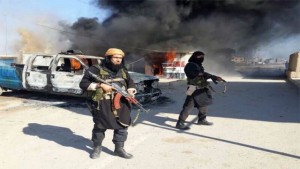 One of the Islamic State’s top leaders in Iraq’s Anbar province was killed in a U.S. airstrike last week, the Pentagon said Monday.The “military emir” of Anbar, known as Abu Wahib, and three other Islamic State members were killed May 6 while traveling in a vehicle near the town of Rutbah in western Iraq, Pentagon press secretary Peter Cook said.
One of the Islamic State’s top leaders in Iraq’s Anbar province was killed in a U.S. airstrike last week, the Pentagon said Monday.The “military emir” of Anbar, known as Abu Wahib, and three other Islamic State members were killed May 6 while traveling in a vehicle near the town of Rutbah in western Iraq, Pentagon press secretary Peter Cook said.
“ISIL leadership has been hit hard by coalition efforts and this is another example of that,” Cook told reporters, using an acronym for the Islamic State. “It is dangerous to be an ISIL leader in Iraq and Syria these days and for good reason.” Abu Wahib was a legacy member of the Islamic State. He started out with the group’s earlier iteration, al-Qaeda in Iraq, before being detained by U.S. forces in the mid-2000s. He was transferred to an Iraqi prison after the U.S. withdrawal in 2011 and was broken out shortly after.
His death has been falsely reported before, as have those of many other Islamic State leaders. Earlier this year, for instance, Abu Wahib was believed to have been killed in an airstrike near the town of Hit during pitched fighting between Iraqi forces and Islamic State fighters there. If true, the U.S. strike ended the career of one of the most colorful, and most brutal, commanders in the Islamic State. Media-savvy and obsessively image-conscious, Abu Wahib gained notoriety through a series of self-made videos that promoted his fighting prowess while showcasing his cold-bloodedness.
A former Iraqi computer programmer believed to be about 30, he styled himself after one of the Islamic State’s founding figures, the Jordanian-born Abu Musab al-Zarqawi, who led al-Qaeda in Iraq before being killed in a U.S. airstrike in 2006. Like Zarqawi, Abu Wahib preferred ninja-like black clothing and sported a shaggy mane and beard. Also like Zarqawi — and in contrast with other Islamic State leaders who largely avoid the spotlight — he adored the camera, allowing himself to be depicted showing off martial-arts techniques or firing his weapon.
His most notorious video performance depicts Abu Wahib harassing, and then murdering, three Syrian civilian truck drivers whose vehicles were stopped along an Iraqi highway in 2013. In a grisly scene recorded by his videographers, he accuses the drivers of being Syrian Shiites — viewed by the Islamic State as heretics — and proceeds to question them about religious practices. “What proves to me that you’re Sunni?” he asks the drivers. “How many kneelings do you make at dawn prayer?” When the men give contradictory answers, Abu Wahib executes them on the spot, leaving their bodies on the side of the highway.
A year later, Abu Wahib was instrumental in the Islamic State’s series of military victories in Iraq’s western Anbar province. Videos posted to social media sites depict Abu Wahib personally commanding assaults on government buildings in the provincial capital, Ramadi. The successes in Anbar were aided at times by Iraqi tribesmen who viewed the Islamic State’s fighters as allies and kinsmen. Born Shaker Wahib al-Fahdawi al-Dulaim, Wahib belonged to one of Iraq’s largest tribes, the Dulaimis.
In death, Abu Wahib joins a growing list of leaders whom the Pentagon has claimed to have removed from the battlefields of Iraq and Syria. In March, a special operations raid targeted Abd al-Rahman Mustafa al-Qaduli, the terrorist group’s second in command in eastern Syria. Two weeks before Qaduli’s killing, the Pentagon confirmed the death of Abu Omar al-Shishani, considered the Islamic State’s “secretary of defense.”
The Islamic State still holds significant swaths of territory in Iraq and Syria and has demonstrated an ability to conduct offensive operations despite frequent airstrikes and raids by the U.S.-led coalition. Earlier this month, a group of fighters managed to penetrate Kurdish lines in northern Iraq, killing a U.S. Navy SEAL.
